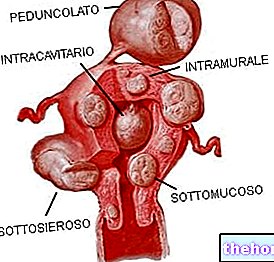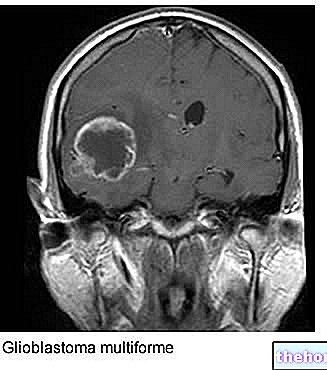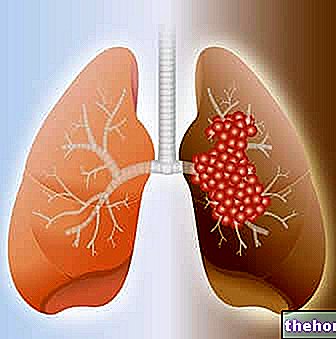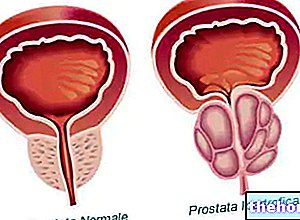
Several factors may affect its appearance, including: an unhealthy diet, obesity, smoking, sedentary lifestyle, intestinal polyps, family predisposition, some hereditary diseases and inflammatory bowel diseases.
More frequent in the rectum, colon adenocarcinoma is responsible for less specific symptoms (eg blood in the stool, anemia, abdominal pain, abdominal cramps, etc.).
For an accurate diagnosis of colon adenocarcinoma, the following are essential: physical examination, medical history, laboratory tests on blood and feces, instrumental tests (eg colonoscopy) and tumor biopsy.
Colon adenocarcinoma therapy varies according to the stage of cancer and the patient's general state of health, among the possible treatments include: surgical therapy, radiotherapy, chemotherapy and the so-called "targeted therapy".
Large intestine: a brief anatomical recall
Preceded by the small intestine, the large intestine is the terminal tract of the intestine and digestive system.
It begins at the ileocecal valve and ends at the anus; it is made up of 6 sections (cecum, ascending colon, transverse colon, descending colon, sigma and rectum), is about 2 meters long and has an average diameter of 7 centimeters (hence the name of large intestine).
What is adenocarcinoma?
An adenocarcinoma is a malignant tumor that originates from the uncontrolled proliferation of a cell belonging to a tissue with secretory properties (therefore a mucosa) or to an exocrine gland.
Adenocarcinomas are the malignant version of adenomas (benign tumors).
The targets of the aforementioned genetic mutations are genes that control cell growth and division, which explains why tumors such as colon adenocarcinoma are characterized by an uncontrolled cell proliferation process.
What are the Causes of Colon Adenocarcinoma?

Currently, the precise causes of colon adenocarcinoma are unknown; scientific evidence on the subject, however, suggests that a number of specific factors contribute to the appearance of this malignant tumor, including:
- The presence along the colorectal of adenomatous polyps. The adenomatous polyps (or simply adenomas) of the colorectal are benign tumors that have a by no means negligible ability to transform into malignant neoplasms, that is, into adenocarcinomas.
- The presence of hereditary conditions associated with the development of benign or malignant tumors along the gastrointestinal tract (e.g. Lynch II syndrome and familial adenomatous polyposis). Scientific studies have shown that those who are carriers of these hereditary conditions have a high risk of getting colon adenocarcinoma, starting as early as 30-40 years old.
- Some familiarity with colorectal cancers;
- An unhealthy diet, in which the consumption of red meat, fatty foods of animal origin and fried foods prevails, and in which dietary fibers and the intake of fresh fruit and vegetables are scarce;
- The presence of an inflammatory bowel disease (e.g. Crohn's disease or ulcerative colitis). These conditions are characterized by "chronic inflammation of the large intestine and the consequent alteration of the anatomical structure of the latter";
- Older age. Generally, the accumulation of mutations underlying cancers such as colon cancer is a slow process that takes many years;
- Obesity, cigarette smoking, sedentary lifestyle and alcohol consumption. Statistical studies have shown that obese, heavy alcoholic drinkers, smokers and inactive people, when compared with people of normal weight, abstainers, non-smokers and people with an active life, show a greater tendency to develop colorectal adenocarcinoma;
- Belonging to the African-American population. When compared with other more common populations (eg Caucasian or Asian), the African-American population demonstrates a particular predisposition to colon adenocarcinoma (the reasons behind this predisposition are unknown) .
Curiosity
According to some reliable research, more than 70% of cases of colon adenocarcinoma are not linked to genetic or family risk factors, but to: excessive consumption of red meat, fatty foods and alcohol, cigarette smoking, l " obesity, a sedentary lifestyle and the presence of adenomatous polyps.
Epidemiology
Rare in the population under the age of 40, colon adenocarcinoma predominantly affects people between the ages of 60 and 75.
As stated earlier when discussing risk factors, colon adenocarcinoma has a particular "preference" for the African-American population.
Globally, every year, colon adenocarcinoma and other types of large bowel neoplasms independently affect more than one million people and together represent the second most common form of cancer among women. , and the third most common form of cancer, among men.
In Italy, according to a figure from the Italian Cancer Registry Association dating back to 2017, every year there are about 23,000 new cases of colon adenocarcinoma, among women, and about 30,000, among men.
, with a broad symptom picture, not very specific and dependent on its localization along the large intestine.
Common Symptoms of Colon Adenocarcinoma

The most common clinical manifestations of colon adenocarcinoma are:
- Change in intestinal habits (eg alternation of diarrhea-constipation, changes in the consistency of stools, etc.);
- Blood in the stool, the result of internal bleeding;
- Abdominal pain;
- Cramps in the lower abdomen
- Abdominal swelling
- Rectal bleeding;
- Sensation of incomplete emptying of the intestine after defecation;
- Burning and anal itching;
- Anemia;
- Weakness and ease of fatigue;
- Weight loss for no reason
- Dyspnea.
Most common locations
The most common localization of colorectal adenocarcinoma is the rectum (about 50% of cases), followed by sigma (19-21% of cases), ascending colon (16%), transverse colon (8%) and from the descending colon (6% of cases).
Complications
Over time, the expansion of an adenocarcinoma of the colon leads to obstruction of the intestinal lumen, with consequent blockage of fecal transit (intestinal obstruction or intestinal blockage).
Like most malignant tumors, moreover, colon adenocarcinoma has an infiltrative power, which allows it, in an advanced stage of the disease, to invade the anatomically adjacent organs and lymph nodes and disseminate, through the blood and lymph, metastases (i.e. cancer cells) in anatomically distant organs and lymph nodes.
The organs most affected by colon adenocarcinoma metastases include the liver, lungs, bones and brain.
Importance of Tumor Biopsy
Tumor biopsy is the only diagnostic test that allows us to establish, with absolute certainty, the stage of advancement (or staging) of colon adenocarcinoma.
For treating physicians, knowledge of the staging of a neoplasm is essential for planning the most appropriate therapy.

STADIATION OF THE ADENOCARCINOMA OF THE COLON
According to the so-called Dukes classification, there are four possible stages of progression of a colorectal adenocarcinoma: stage A, stage B, stage C and stage D.
- Stage A: it is the least severe stage.
At this stage, the tumor resides almost exclusively on the mucous membrane of the intestine; rarely, it pushes into the layers below the mucosa.
It never affects the lymph nodes; - Stage B: is the stage of gravity immediately following stage A.
At this stage, the tumor mass has penetrated beyond the intestinal mucosa and affects the underlying muscle layer.
Even in such circumstances, it never involves any lymph nodes. - Stage C: on a scale of increasing severity, it ranks second.
At this stage, the tumor has pushed beyond the muscular layer, also invading the outermost layer of the intestinal wall and the first regional lymph nodes. - Stage D: it is the most serious stage.
At this stage, the tumor has affected most of the regional lymph nodes and has spread metastases in various organs of the body.
Surgical Therapy

The surgical approach to colon adenocarcinoma varies according to the progress of the neoplasm (stage of neoplasm).
In the presence of stage A colon adenocarcinomas limited to the intestinal mucosa, there are two possible surgical approaches, both minimally invasive: the so-called endoscopic resection of the mucosa and removal by laparoscopic technique.
In the presence of a stage B colon adenocarcinoma and stage C colon tumors that are considered curable, surgical therapy consists in the removal of the tract of the large intestine in which the tumor resides; depending on the location of the tumor, the intervention of Removal performed in these circumstances may consist of: partial colectomy (for tumors based in the colon), mesorectal excision (for tumors based in the rectum that have just passed the mucosa), low anterior resection with anastomosis (for tumors with site in the upper part of the rectum) and abdominal-perineal resection (for tumors located near the anus).
It should be noted that this type of surgical approach is associated with intestinal recanalization and, sometimes, also with the removal of regional lymph nodes.
In the presence of stage D and stage C adenocarcinomas of the colon that are considered untreatable, surgical therapy consists of total colectomy or operations aimed at unblocking the intestinal canal from the tumor mass, which, due to its large size, is responsible of the aforementioned phenomenon of intestinal obstruction (or intestinal blockage).
It is a signal that in the presence of tumors at a very advanced stage, where possible, the removal of the organs reached by the metastases is also envisaged.
Radiotherapy and Chemotherapy
Radiotherapy consists in the exposure of a tumor mass to a certain dose of high-energy ionizing radiation, with the aim of destroying the neoplastic cells.
Chemotherapy, on the other hand, consists of the administration, intravenously or orally, of drugs capable of killing rapidly growing cells, including the cells of a tumor.
In the presence of colon adenocarcinoma, radiotherapy and chemotherapy can be used as:
- Pre-surgical treatments (or neoadjuvants), to reduce the size of the tumor mass in order to facilitate its subsequent removal.
- Post-surgical (or adjuvant) treatments, to destroy cancer cells that may have survived after surgical therapy.
- Symptomatic-palliative treatments, when, due to the dissemination of metastases in various parts of the body, an effective removal of the tumor is impractical.
Targeted Therapy
The "targeted therapy" is a treatment based on particular drugs (eg: bevacizumab, ramucirumab, cetuximab, panitumumab, regorafenib etc.), which specifically counteract everything that promotes the growth and development of cancer cells.
In the treatment of colon adenocarcinoma, "targeted therapy" is used as a symptomatic remedy for advanced stage neoplasms.




























